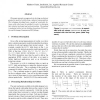100 search results - page 19 / 20 » Representing First-Order Logic Using Graphs |
ICDAR
2003
IEEE
14 years 4 months ago
2003
IEEE
er presents an approach to deriving an abstract geometric model of a table from a physical representation. The technique developed uses a graph of constraints between cells which ...
ERSHOV
2009
Springer
14 years 2 months ago
2009
Springer
A term t is called a template of terms t1 and t2 iff t1 = t1 and t2 = t2, for some substitutions 1 and 2. A template t of t1 and t2 is called the most specific iff for any template...
INTERNET
2007
13 years 10 months ago
2007
evel of abstraction, we can represent a workflow as a directed graph with operators (or tasks) at the vertices (see Figure 1). Each operator takes inputs from data sources or from ...
CIDR
2009
13 years 12 months ago
2009
Recent excitement in the database community surrounding new applications--analytic, scientific, graph, geospatial, etc.--has led to an explosion in research on database storage sy...
SIGSOFT
2002
ACM
14 years 11 months ago
2002
ACM
Program slicing is a potentially useful analysis for aiding program understanding. However, slices of even small programs are often too large to be generally useful. Imprecise poi...

